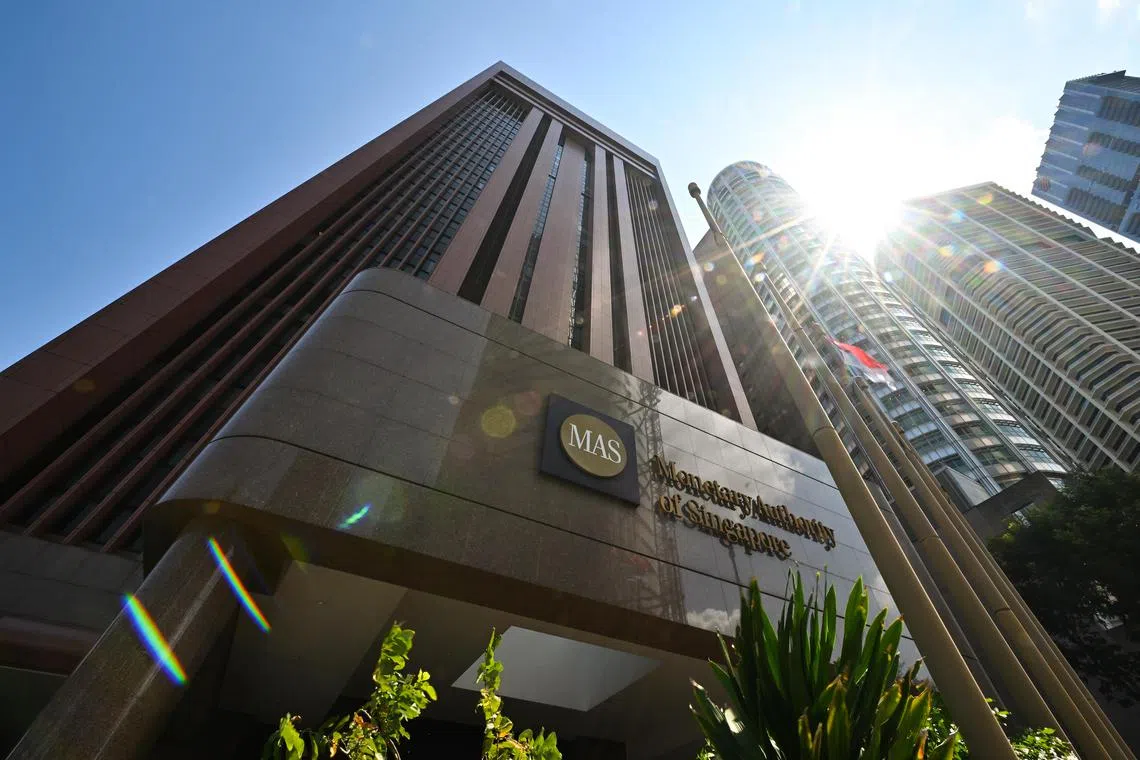MAS keeps support for strong Singdollar; sees core inflation easing to 2% by year-end
Sign up now: Get ST's newsletters delivered to your inbox

MAS has succeeded in bringing down Singapore’s core inflation, which hit 5.5 per cent at its peak in January 2023.
PHOTO: ST FILE
Follow topic:
SINGAPORE – Singapore’s central bank kept unchanged its monetary policy stance that favours a stronger Singapore dollar to curb inflation, which it said would continue to ease through the rest of 2024.
The Monetary Authority of Singapore (MAS) said on Oct 14 that it will maintain the prevailing rate of appreciation in the value of the Singdollar versus a basket of currencies of its major trading partners. MAS refers to this value as the Singdollar nominal effective exchange rate (S$Neer) policy band.
MAS also narrowed its forecast for 2024 core inflation – which excludes private accommodation and transport costs, and better reflects household expenses – to an average of 2.5 per cent to 3 per cent, from an earlier range of 2.5 per cent to 3.5 per cent.
It also said that the gauge should end the year around 2 per cent.
In 2025, core inflation is expected to average around the midpoint of the forecast range of 1.5 per cent to 2.5 per cent, MAS noted.
The central bank has succeeded in bringing down core inflation, which hit 5.5 per cent at its peak in January 2023. Still, core inflation picked up to 2.7 per cent in August, after falling to 2.5 per cent in July, its lowest since 2022.
However, MAS bucked the global easing trend seen in the first interest rate cuts in four years by the US Federal Reserve,
Unlike other central banks, MAS uses the S$Neer policy band to manage inflation. It guides the local dollar against a basket of currencies of its major trading partners to crimp the cost of imports.
It has to balance this against the risk of a too-strong Singdollar that would make exports more expensive to overseas markets and deter tourists from visiting Singapore.
Economic growth as measured by the pace of gross domestic product (GDP) growth gained momentum in the third quarter of 2024.
The Ministry of Trade and Industry (MTI) on Oct 14 said the Singapore economy grew 4.1 per cent year on year in the third quarter
MTI had already narrowed its estimate for 2024 GDP growth in August to a range of 2 per cent to 3 per cent, the upper end of its earlier projection of 1 per cent to 3 per cent.
MAS in its statement said Singapore’s growth momentum has picked up. “Barring a weakening in global final demand, the economy should continue to expand at a steady pace and keep close to its potential path in 2025,” it said.
Still, it noted that the risks to Singapore’s inflation outlook are more balanced compared with July, the last time it reviewed monetary policy.
“If there is stronger-than-anticipated demand for labour due to upsides in GDP growth, it may take longer for unit labour cost growth to moderate and consequently for services price inflation to normalise.”
Also, an intensification of geopolitical tensions and commodity price shocks could add to imported costs, it said. The reference to “commodity price shock” is in relation to the recent surge in global crude oil prices as the conflict in the Middle East escalates.

Higher oil prices can drive up prices of products made out of it, such as petrol, diesel, jet fuel and fuel oils used in ships. With a lag, oil prices also influence the cost of coal and natural gas – the dominant fuels in power generation.
However, MAS said: “A significant downturn in the global economy would induce an abrupt easing in cost and price pressures, causing domestic inflation to come in materially lower than expected.”
This is the sixth time in a row that MAS has stood pat on its Singdollar policy.
The currency was little changed after the widely expected MAS decision. It was trading at 1.3058 per US dollar at 12.25pm on Oct 14 after the MAS statement was released, barely moving from its close the previous day.
Analysts said the sanguine growth outlook and the central bank’s forecast for lower inflation later in 2024 and in 2025 means MAS will not be in a rush to shift its stance.
Ms Selena Ling, chief economist and head of global markets research and strategy at OCBC Bank, said a possible easing may happen at MAS’ next meeting in January or the one in April.
“Core inflation should dip below 2 per cent as early as the first quarter of 2025, and if it materialises, it should give MAS more flexibility to ease its monetary policy stance at the upcoming 2025 quarterly policy reviews,” she said.


